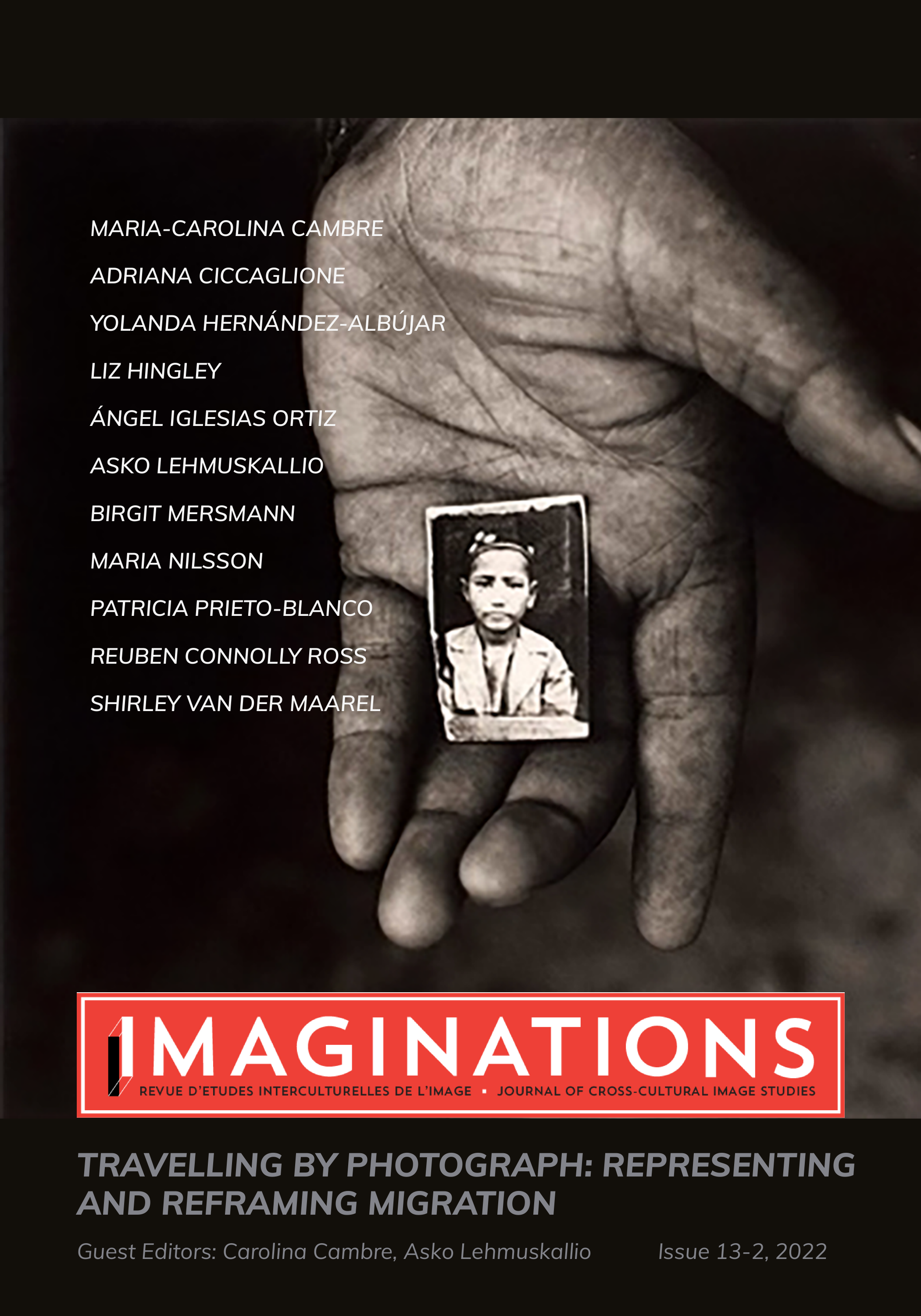The Wall and the Politics of Exclusion and Inclusion at Baja California Borderlands: A Pictorial Journey
DOI:
https://doi.org/10.17742/IMAGE.TP.13.2.7Abstract
The essay considers the border wall between Mexico and the United States as its primary visual, symbolic, and material reference to reflect on the politics of exclusion and inclusion entangled in everyday discourses and practices in Baja California’s borderlands. Everyday bordering applies not only to governmental technologies of control but also to these sorts of politics. The essay proposes that the wall represents an exclusionary symbol that is nonetheless challenged by those who attempt to embed inclusion in this context. The pictorial journey shows aspects of common situations next to the wall between the Mexican cities of Mexicali and Tijuana.References
Albicker, Sandra Luz, and Laura Velasco. “Deportación y Estigma en la Frontera México-Estados Unidos: Atrapados en Tijuana.” Norteamérica, vol. 11, no.1, 2016, pp. 99-129.
Alvarez, Robert “Reconceptualizing the Space of the Mexico–US Borderline.” A Companion to Border Studies. Edited by Thomas Wilson and Donnan Hastings. Wiley Blackwell, 2012, pp. 538-556.
Anguiano, María Eugenia and Daniel Villafuerte. Migrantes en Tránsito a Estados Unidos: Vulnerabilidades, Riesgos y Resiliencia. El Colegio de La Frontera Norte Tijuana, 2016.
Banks, Markus. Using Visual Data in Qualitative Research. SAGE, 2006.
Bonansinga, Kate. Curating at the Edge. University of Texas Press, 2014.
Brambilla, Chiara. “Exploring the Critical Potential of Borderscape Concept.” Geopolitics, vol. 20, no.1, 2015, pp.14-34.
De Genova, Nicholas P. “Spectacles of migrant ‘illegality’: the scene of exclusion, the obscene of inclusion.” Ethnic and racial Studies, 36:7, 2013, pp. 1180-98.
Farman, Abou. “The Political Aesthetics of Border Walls.” Anthropology Now, vol. 9, no. 3, 2018, pp. 3-5.
Heyman, Josiah. “Why Interdiction? Immigration Control at the United States‐Mexico Border.” Regional Studies, vol. 33, no. 7, 1999, pp. 619-30.
Jenkins, Richard. Social Identity. Routledge, 2008.
Johnson, Corey, Reece Jones, Anssi Paasi, Louise Amoore, Alison Mountz, Mark Salter, Chris Rumford. “Interventions on Rethinking ‘The Border’ in Border Studies.” Political Geography, vol. 30, no. 2, 2011, pp. 61-69.
Madsen, Kenneth. “Graffiti, Art, and Advertising: Re-Scaling Claims to Space at the Edges of the Nation-State.” Geopolitics, vol. 20, no. 1, 2015, pp. 95-120.
Méndez y Berrueta, Luis. “Territorio Maquilador y Violencia. El Caso de Ciudad Juárez.” El Cotidiano, no. 164, 2010, pp. 27-40 http://www.redalyc.org/articulo.oa?id=3251589400. Accessed 19 December 2020.
Mirzoeff, Nicholas. The Right to Look: A Counter History of Visuality. Duke University Press, 2011.
Pötzsh, Holger. “Art Across Borders: Dislocating Artistic and Curatorial Practices in the Barents Euro-Arctic Region.” Journal of Borderland Studies, vol. 30, no.1, 2015, pp. 111-125.
Rajaram, Prem Kumar and Carl Grundy-Warr. “Introduction.” Borderscapes: Hidden Geographies and Politics at Territory’s Edge. Edited by Prem Kumar Rajaram and Carl Grundy-Warr. University of Minnesota Press, 2008, pp. ix-xl.
Regan, Margaret. “How the Border Wall Became a Canvas.” Border Spaces: Visualizing the U.S.-Mexico Frontera. Edited by Katherine Morrissey and John-Michael Warner. The University of Arizona Press, 2018, pp. 151-174.
Rose, Gillian. Visual Methodologies. Sage, 2016.
Rose, Gillian and Divya Tolia-Kelly. “Visuality/Materiality: Introducing a Manifesto for Practice.” Visuality/Materiality: Image, Objects and Practices. Edited by Gillian Rose and Divya P. Tolia-Kelly. Routledge, 2016, pp. 1-12.
Rosello, Mireille and Stephan Wolfe. “Introduction.” Border Aesthetics Concepts and Intersections. Edited by Johan Schimanski and Stephan Wolfe. Berghahn, 2019, pp. 1-24.
Schimanski, Johan. “Border Aesthetics and Cultural Distancing in the Norwegian-Russian Borderscape.” Geopolitics, vol. 20, no.1, 2015, pp. 35-55.
Slack Jeremy, Daniel E. Martínez, Whiteford Scott, and Emily Peiffer. “In Harm’s Way: Family Separation, Immigration Enforcement Programs and Security on the US-Mexico Border”. Journal on Migration and Human Security, 3(2), 2015, pp.109-128.
Torres, Karina. “Hay 3 Mil Personas sin Hogar en el Centro.” El Sol de Tijuana. 10 October 2018, https://www.elsoldetijuana.com.mx/local/hay-3-mil-personas-sin-hogar-en-centro-2089956.html. Accessed 15 December 2020.
U.S. Department Home Security “On October 30th 2020, U.S. Government Informed Nearly 400 Miles of New Border Wall System is Now Complete” 29 October 2020. https://www.whitehouse.gov/articles/new-border-wall-nears-400-miles/. Accessed 15 December 2020.
USCIS, U.S. Citizenship and Immigration Services. Unlawful Presence and Bars to Admissibility. 23 July 2020. https://www.uscis.gov/laws-and-policy/other-resources/unlawful-presence-and-bars-to-admissibility. Accessed 13 January 2021.
Velasco, Laura and Sandra Luz Albicker. Estimación y Caracterización de la Población Residente en ‘El Bordo’ del Canal del Río Tijuana. El Colegio de la Frontera Norte, 2013.
Vila, Pablo. Ethnography at the Border. University of Minnesota Press, 2003.
Yuval-Davis, Nira. “Autochthonic Populism, Everyday Bordering and the Construction of the ‘Migrant’.” Populism and the Crisis of Democracy. Edited by Gregor Fitzi, Jürgen Mackert, and Bryan S. Turner. Routledge, 2019, pp. 69-77.
Downloads
Published
How to Cite
Issue
Section
License
Copyright (c) 2022 Angel Iglesias Ortiz

This work is licensed under a Creative Commons Attribution-NonCommercial-NoDerivatives 4.0 International License.

This work by https://journals.library.ualberta.ca/imaginations is licensed under a Creative Commons 4.0 International License although certain works referenced herein may be separately licensed, or the author has exercised their right to fair dealing under the Canadian Copyright Act.




